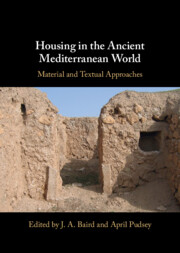Book contents
- Housing in the Ancient Mediterranean World
- Housing in the Ancient Mediterranean World
- Copyright page
- Contents
- Figures
- Tables
- Contributors
- Acknowledgements
- Introduction
- 1 Kinship ‘In the Halls’
- 2 Domesticating the Ancient House
- 3 Mind the Gap
- 4 A Family Affair
- 5 Textiles in Alkestis’ thalamos
- 6 Architectural Rhetoric and the Rhetoric of Architecture
- 7 The Reconstruction of an Agricultural Landscape
- 8 Mudbricks and Papyri from the Desert Sand
- 9 Housing and Community
- 10 The Elusive vestibulum
- 11 Living in the Liminal
- 12 Experiencing Sense, Place and Space in the Roman Villa
- 13 Houses and Time
- 14 Spaces of Desire
- 15 A Response: ‘Using the Material and Written Sources’ Revisited
- Index
- References
4 - A Family Affair
The Household Use of Attic lekythoi*
Published online by Cambridge University Press: 08 July 2022
- Housing in the Ancient Mediterranean World
- Housing in the Ancient Mediterranean World
- Copyright page
- Contents
- Figures
- Tables
- Contributors
- Acknowledgements
- Introduction
- 1 Kinship ‘In the Halls’
- 2 Domesticating the Ancient House
- 3 Mind the Gap
- 4 A Family Affair
- 5 Textiles in Alkestis’ thalamos
- 6 Architectural Rhetoric and the Rhetoric of Architecture
- 7 The Reconstruction of an Agricultural Landscape
- 8 Mudbricks and Papyri from the Desert Sand
- 9 Housing and Community
- 10 The Elusive vestibulum
- 11 Living in the Liminal
- 12 Experiencing Sense, Place and Space in the Roman Villa
- 13 Houses and Time
- 14 Spaces of Desire
- 15 A Response: ‘Using the Material and Written Sources’ Revisited
- Index
- References
Summary
The Classical house can be understood also as a set of interactions between people, objects and valuable commodities that existed within and extended beyond the physical and temporal confines of the house. This chapter concerns ceramic oil jars, lekythoi, that date to the early 5th century BCE. It is argued that the small black-figured lekythoi, which were prolifically produced and widely traded during this time, may have held olive oil, not just perfume. The materiality of these pots and archaeological evidence from settlements, graves and other find-spots suggest that lekythoi could have functioned as oil pitchers to serve small portions of olive oil, perhaps of family production. Vase iconography indicates that such lekythoi were objects within easy reach, to be used on diverse occasions, such as dining, ritual and commercial activities. The offering of lekythoi in burials, irrespective of the presence of contents, could have alluded to the storage of olive oil in the household of the deceased and communicated a powerful message about a family’s claims to status, real or fictitious.
- Type
- Chapter
- Information
- Housing in the Ancient Mediterranean WorldMaterial and Textual Approaches, pp. 133 - 180Publisher: Cambridge University PressPrint publication year: 2022

